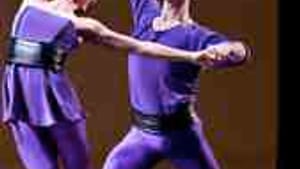Stay in the Loop
BSR publishes on a weekly schedule, with an email newsletter every Wednesday and Thursday morning. There’s no paywall, and subscribing is always free.
Big names, hard work, dazzling technique... But what does it mean?
Pennsylvania Ballet's "Russian Suite'

Can a dance form rooted in the distant past remain vibrant and fresh? That's the challenge confronted by ballet companies (not to mention all high-level arts organizations).
This year the New York City Ballet presented a new ballet with music and libretto by Paul McCartney, with his daughter Stella tossed in to make the costumes. Its rival, the American Ballet Theater, signed up (until 2023) Alexei Ratmansky, the former Bolshoi artistic director whom the New Yorker's dance critic Joan Acocella called "the most looked-to choreographer in Western ballet."
And now the Pennsylvania Ballet, unable to commission a new dance from Ratmansky, has obtained the North American premiere of Jeu de Cartes, which Ratmansky created in 2005 for the Bolshoi Ballet. The Philadelphia performance of Ratmansky's re-working of the Stravinsky neo-Classical music of 1937, set to dance then by Balanchine, raises the question: Are these artist celebrity choices the answer for the future of ballet?
Jeu de Cartes (The Card Play) is an aggressively playful, abstract ensemble work that extends the physical ranges of this already talented company. Ratmansky turns on the speed and precision of his dancers in a manner that eschews the literalness of past Jeu de Cartes, which had apparently adhered closely to the card-playing words of its title.
Like a deck of cards
Trios of men and women dance hulking, stalking walks with their necks inelegantly foreshortened, as extended arms snake forward. Men jump high, straight up in spiraling turns and, instead of landing softly on their feet in traditional balletic silence, drop their bodies to the floor (in near silences). Lifted women kick straight legs directly at the audience in a balletic pow! Male dancers, in classical precision, nail jumps with their upper and lower bodies, alternating left and right hitting diagonals as legs beat like flickering hummingbirds.
Ratmansky pays homage to the roots of the dance with an occasional reference to card playing, as when a dancer crouches low to lay out and turn over cards, or when the entire ensemble collapses in sequence as a card deck unravels. The multiple lighting and costume changes employing complementary colors of purple and shades of yellow and green add to the vital energy of this cascading piece, which revels in its ensemble interplay, in lieu of the hierarchies of dancing characters that are more common to ballet.
Exhausting rehearsals
Ratmansky "kicked our butts" during his one exhausting rehearsal week in Philadelphia, one dancer told me. (In a welcome move, the Ballet website has posted a short video by Alexander Iziliaev of some of the dynamic dancing in rehearsal.) The resulting performance left no doubt that Ratmansky developed and expanded the company's potential.
But the work itself hewed much closer to conventional modern ballet, showing insufficient invention for a 21st-Century ballet. The performance offered too much of the ballet confection that's immediately pleasing to the taste of audiences, and little of substance or meaning.
Recycled Balanchine
If Jeu de Cartes was at least a contemporary sweet, the opening Balanchine Raymonda Variations from 1961 was a confection in pink, evocative of the classical ballet of decades earlier. This piece is primarily a work of solo variations set to Alexander Glazunov's soupy romantic score; it showcased the fine virtuoso technique of its dancers who impressively hopped on point, or ran a series of almost non-stop jumps and turns. But after admiring the dancers, one was left asking: Why present this work today?
Slaughter on Tenth Avenue, the company's closing work, was a crowd pleaser burdened with its share of stale, dated humor. Balanchine had first choreographed it for On Your Toes, a 1936 Broadway musical by Richard Rogers and Lorenz Hart that was the first to incorporate a jazz score as well as classical ballet. Its spoof of a plot carries into the dance sequence, set in a strip joint, where ballet-world jealousy mixes improbably with a thwarted mob hit.
One note of humor
A swarthily alive Andrew Daly, as the tapping and soft-shoeing Hoofer, and the radiant Lauren Fadeley, reveling in physical sexuality as the Strip Tease Girl, brought the piece to life. The wacky choreography of the Keystone Cops— the jumping-jack trio of James Ihde, Jermel Johnson and Lorin Mathis— injected the sole levity in a narrative that otherwise struck out for humor.
Will the in-demand Russian from Moscow, in tandem with re-cycled Balanchine, be the answer for the Pennsylvania Ballet? Its dancers and audience, not to mention the future the future of ballet, may need much more.
This year the New York City Ballet presented a new ballet with music and libretto by Paul McCartney, with his daughter Stella tossed in to make the costumes. Its rival, the American Ballet Theater, signed up (until 2023) Alexei Ratmansky, the former Bolshoi artistic director whom the New Yorker's dance critic Joan Acocella called "the most looked-to choreographer in Western ballet."
And now the Pennsylvania Ballet, unable to commission a new dance from Ratmansky, has obtained the North American premiere of Jeu de Cartes, which Ratmansky created in 2005 for the Bolshoi Ballet. The Philadelphia performance of Ratmansky's re-working of the Stravinsky neo-Classical music of 1937, set to dance then by Balanchine, raises the question: Are these artist celebrity choices the answer for the future of ballet?
Jeu de Cartes (The Card Play) is an aggressively playful, abstract ensemble work that extends the physical ranges of this already talented company. Ratmansky turns on the speed and precision of his dancers in a manner that eschews the literalness of past Jeu de Cartes, which had apparently adhered closely to the card-playing words of its title.
Like a deck of cards
Trios of men and women dance hulking, stalking walks with their necks inelegantly foreshortened, as extended arms snake forward. Men jump high, straight up in spiraling turns and, instead of landing softly on their feet in traditional balletic silence, drop their bodies to the floor (in near silences). Lifted women kick straight legs directly at the audience in a balletic pow! Male dancers, in classical precision, nail jumps with their upper and lower bodies, alternating left and right hitting diagonals as legs beat like flickering hummingbirds.
Ratmansky pays homage to the roots of the dance with an occasional reference to card playing, as when a dancer crouches low to lay out and turn over cards, or when the entire ensemble collapses in sequence as a card deck unravels. The multiple lighting and costume changes employing complementary colors of purple and shades of yellow and green add to the vital energy of this cascading piece, which revels in its ensemble interplay, in lieu of the hierarchies of dancing characters that are more common to ballet.
Exhausting rehearsals
Ratmansky "kicked our butts" during his one exhausting rehearsal week in Philadelphia, one dancer told me. (In a welcome move, the Ballet website has posted a short video by Alexander Iziliaev of some of the dynamic dancing in rehearsal.) The resulting performance left no doubt that Ratmansky developed and expanded the company's potential.
But the work itself hewed much closer to conventional modern ballet, showing insufficient invention for a 21st-Century ballet. The performance offered too much of the ballet confection that's immediately pleasing to the taste of audiences, and little of substance or meaning.
Recycled Balanchine
If Jeu de Cartes was at least a contemporary sweet, the opening Balanchine Raymonda Variations from 1961 was a confection in pink, evocative of the classical ballet of decades earlier. This piece is primarily a work of solo variations set to Alexander Glazunov's soupy romantic score; it showcased the fine virtuoso technique of its dancers who impressively hopped on point, or ran a series of almost non-stop jumps and turns. But after admiring the dancers, one was left asking: Why present this work today?
Slaughter on Tenth Avenue, the company's closing work, was a crowd pleaser burdened with its share of stale, dated humor. Balanchine had first choreographed it for On Your Toes, a 1936 Broadway musical by Richard Rogers and Lorenz Hart that was the first to incorporate a jazz score as well as classical ballet. Its spoof of a plot carries into the dance sequence, set in a strip joint, where ballet-world jealousy mixes improbably with a thwarted mob hit.
One note of humor
A swarthily alive Andrew Daly, as the tapping and soft-shoeing Hoofer, and the radiant Lauren Fadeley, reveling in physical sexuality as the Strip Tease Girl, brought the piece to life. The wacky choreography of the Keystone Cops— the jumping-jack trio of James Ihde, Jermel Johnson and Lorin Mathis— injected the sole levity in a narrative that otherwise struck out for humor.
Will the in-demand Russian from Moscow, in tandem with re-cycled Balanchine, be the answer for the Pennsylvania Ballet? Its dancers and audience, not to mention the future the future of ballet, may need much more.
What, When, Where
Pennsylvania Ballet: “Russian Suite.†Choreography by George Balanchine and Alexei Ratmansky Oct. 20-23, 2011, at Academy of Music, Broad and Locust Sts. (215) 551-7000 or www.paballet.org.
Sign up for our newsletter
All of the week's new articles, all in one place. Sign up for the free weekly BSR newsletters, and don't miss a conversation.
 Jonathan M. Stein
Jonathan M. Stein